engine coolant Lancia Thesis 2007 Owner handbook (in English)
[x] Cancel search | Manufacturer: LANCIA, Model Year: 2007, Model line: Thesis, Model: Lancia Thesis 2007Pages: 386, PDF Size: 8.69 MB
Page 10 of 386
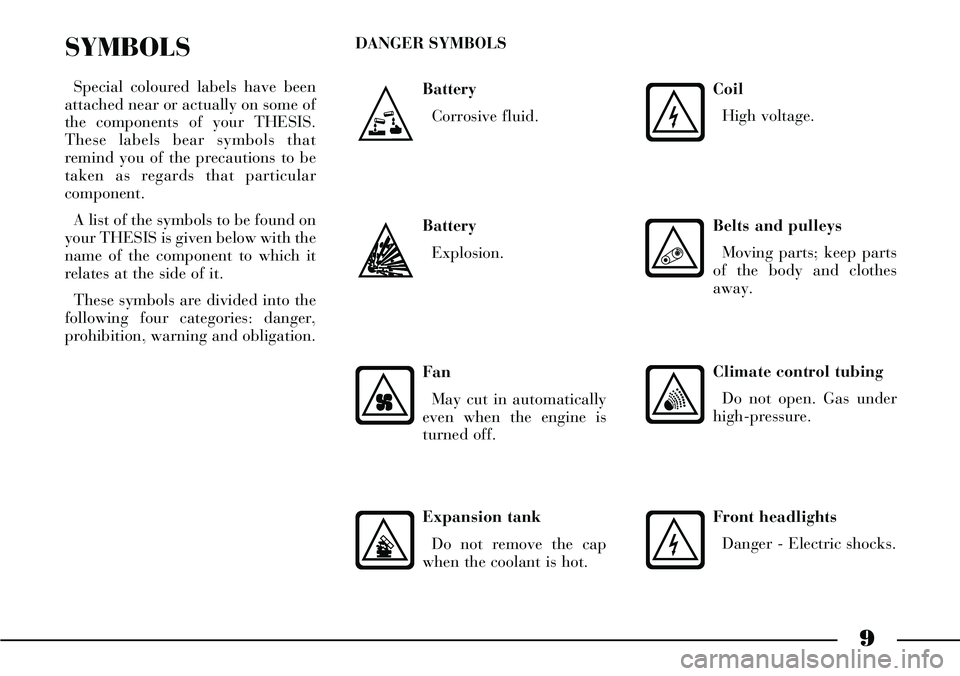
9
Battery
Corrosive fluid.
SYMBOLS
Special coloured labels have been
attached near or actually on some of
the components of your THESIS.
These labels bear symbols that
remind you of the precautions to be
taken as regards that particular
component.
A list of the symbols to be found on
your THESIS is given below with the
name of the component to which it
relates at the side of it.
These symbols are divided into the
following four categories: danger,
prohibition, warning and obligation.DANGER SYMBOLS
Battery
Explosion.
Fan
May cut in automatically
even when the engine is
turned off.
Expansion tank
Do not remove the cap
when the coolant is hot.
Coil
High voltage.
Belts and pulleys
Moving parts; keep parts
of the body and clothes
away.
Climate control tubing
Do not open. Gas under
high-pressure.
Front headlights
Danger - Electric shocks.
Page 106 of 386
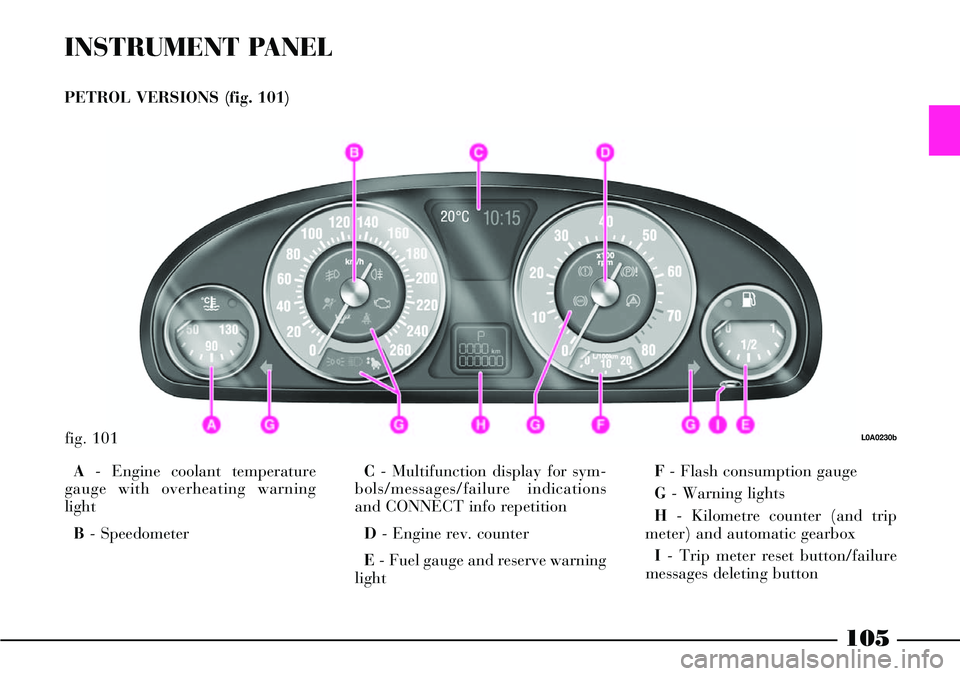
INSTRUMENT PANEL
PETROL VERSIONS (fig. 101)
A- Engine coolant temperature
gauge with overheating warning
light
B- SpeedometerC- Multifunction display for sym-
bols/messages/failure indications
and CONNECT info repetition
D- Engine rev. counter
E- Fuel gauge and reserve warning
lightF- Flash consumption gauge
G- Warning lights
H- Kilometre counter (and trip
meter) and automatic gearbox
I- Trip meter reset button/failure
messages deleting button
fig. 101L0A0230b
105
Page 107 of 386
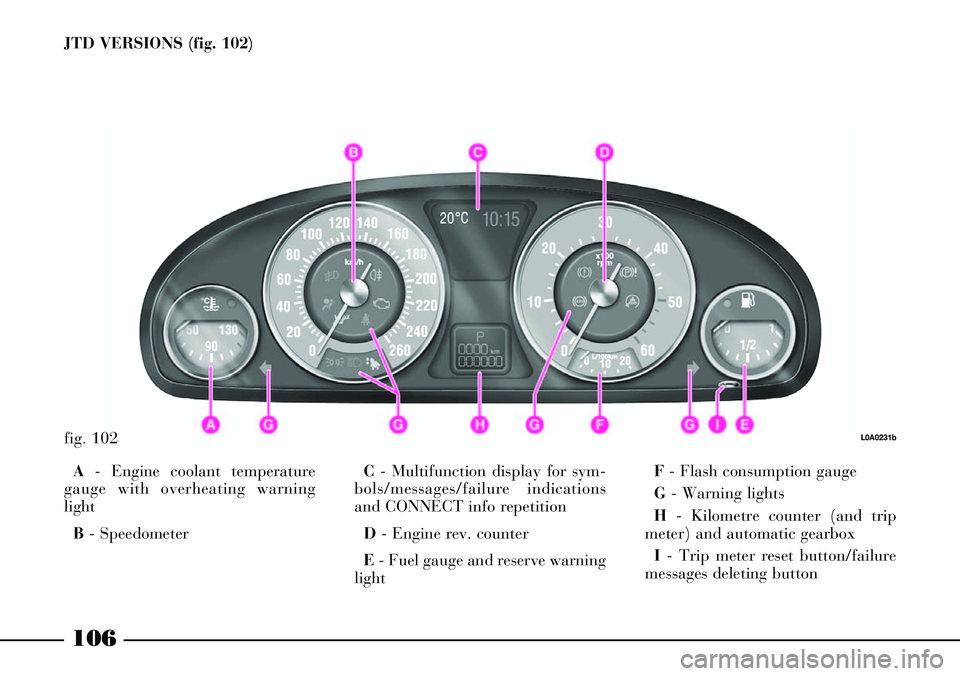
106
JTD VERSIONS (fig. 102)
fig. 102L0A0231b
A- Engine coolant temperature
gauge with overheating warning
light
B- SpeedometerC- Multifunction display for sym-
bols/messages/failure indications
and CONNECT info repetition
D - Engine rev. counter
E- Fuel gauge and reserve warning
lightF- Flash consumption gauge
G- Warning lights
H- Kilometre counter (and trip
meter) and automatic gearbox
I- Trip meter reset button/failure
messages deleting button
Page 109 of 386
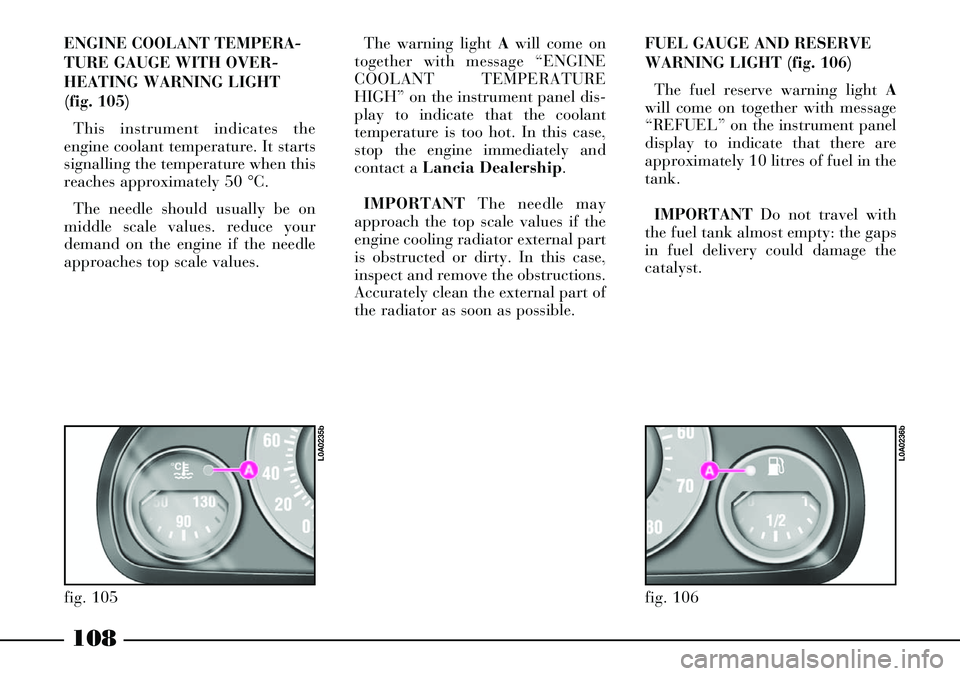
108
fig. 106
L0A0236b
ENGINE COOLANT TEMPERA-
TURE GAUGE WITH OVER-
HEATING WARNING LIGHT
(fig. 105)
This instrument indicates the
engine coolant temperature. It starts
signalling the temperature when this
reaches approximately 50 °C.
The needle should usually be on
middle scale values. reduce your
demand on the engine if the needle
approaches top scale values.The warning light Awill come on
together with message “ENGINE
COOLANT TEMPERATURE
HIGH” on the instrument panel dis-
play to indicate that the coolant
temperature is too hot. In this case,
stop the engine immediately and
contact a Lancia Dealership.
IMPORTANTThe needle may
approach the top scale values if the
engine cooling radiator external part
is obstructed or dirty. In this case,
inspect and remove the obstructions.
Accurately clean the external part of
the radiator as soon as possible.FUEL GAUGE AND RESERVE
WARNING LIGHT (fig. 106)
The fuel reserve warning light A
will come on together with message
“REFUEL” on the instrument panel
display to indicate that there are
approximately 10 litres of fuel in the
tank.
IMPORTANTDo not travel with
the fuel tank almost empty: the gaps
in fuel delivery could damage the
catalyst.
fig. 105
L0A0235b
Page 137 of 386
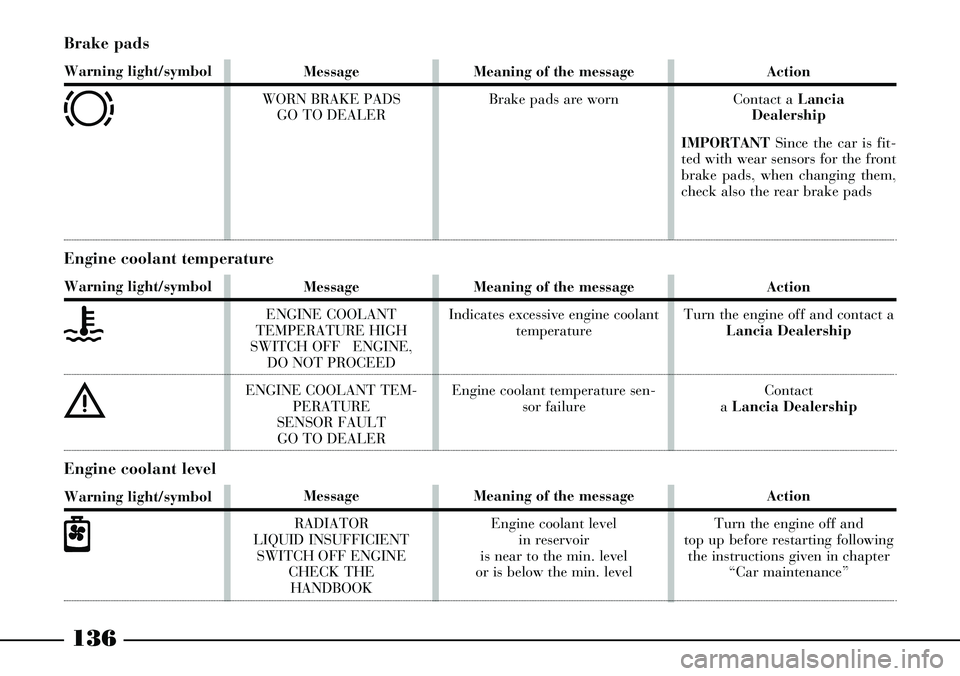
136
Brake pads
Warning light/symbol
d
Message
WORN BRAKE PADS
GO TO DEALERMeaning of the message
Brake pads are wornAction
Contact a Lancia
Dealership
IMPORTANT Since the car is fit-
ted with wear sensors for the front
brake pads, when changing them,
check also the rear brake pads
Engine coolant temperature
Warning light/symbol
u
è
Message
ENGINE COOLANT
TEMPERATURE HIGH
SWITCH OFF ENGINE,
DO NOT PROCEED
ENGINE COOLANT TEM-
PERATURE
SENSOR FAULT
GO TO DEALERMeaning of the message
Indicates excessive engine coolant
temperature
Engine coolant temperature sen-
sor failureAction
Turn the engine off and contact a
Lancia Dealership
Contact
a Lancia Dealership
Engine coolant level
Warning light/symbol
n
Message
RADIATOR
LIQUID INSUFFICIENT
SWITCH OFF ENGINE
CHECK THE
HANDBOOKMeaning of the message
Engine coolant level
in reservoir
is near to the min. level
or is below the min. levelAction
Turn the engine off and
top up before restarting following
the instructions given in chapter
“Car maintenance”
Page 160 of 386
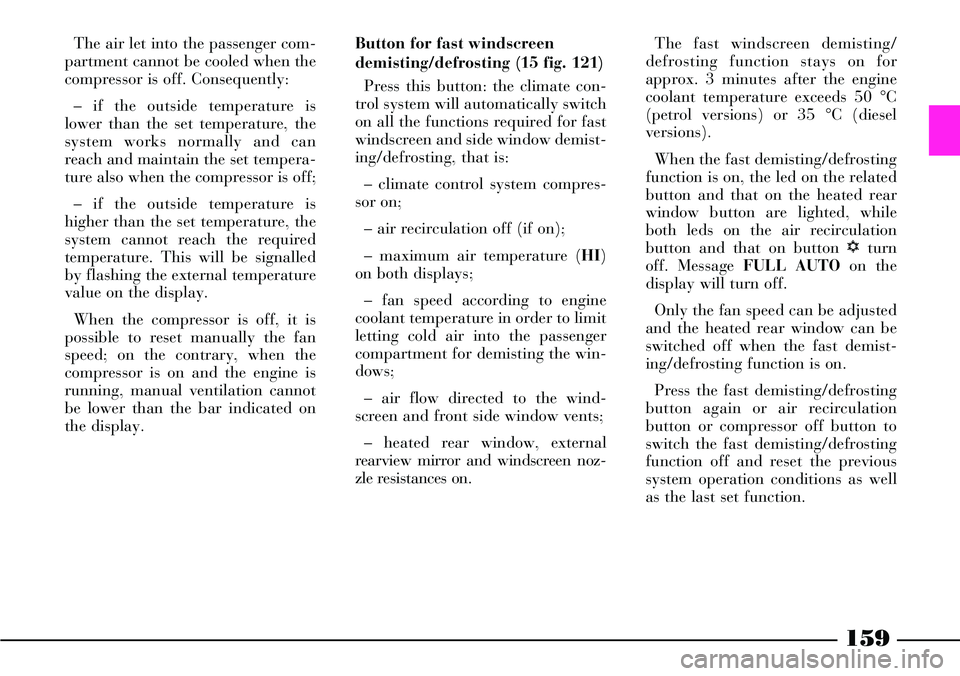
159
The air let into the passenger com-
partment cannot be cooled when the
compressor is off. Consequently:
– if the outside temperature is
lower than the set temperature, the
system works normally and can
reach and maintain the set tempera-
ture also when the compressor is off;
– if the outside temperature is
higher than the set temperature, the
system cannot reach the required
temperature. This will be signalled
by flashing the external temperature
value on the display.
When the compressor is off, it is
possible to reset manually the fan
speed; on the contrary, when the
compressor is on and the engine is
running, manual ventilation cannot
be lower than the bar indicated on
the display. Button for fast windscreen
demisting/defrosting (15 fig. 121)
Press this button: the climate con-
trol system will automatically switch
on all the functions required for fast
windscreen and side window demist-
ing/defrosting, that is:
– climate control system compres-
sor on;
– air recirculation off (if on);
– maximum air temperature (HI)
on both displays;
– fan speed according to engine
coolant temperature in order to limit
letting cold air into the passenger
compartment for demisting the win-
dows;
– air flow directed to the wind-
screen and front side window vents;
– heated rear window, external
rearview mirror and windscreen noz-
zle resistances on.The fast windscreen demisting/
defrosting function stays on for
approx. 3 minutes after the engine
coolant temperature exceeds 50 °C
(petrol versions) or 35 °C (diesel
versions).
When the fast demisting/defrosting
function is on, the led on the related
button and that on the heated rear
window button are lighted, while
both leds on the air recirculation
button and that on button √turn
off. Message FULL AUTOon the
display will turn off.
Only the fan speed can be adjusted
and the heated rear window can be
switched off when the fast demist-
ing/defrosting function is on.
Press the fast demisting/defrosting
button again or air recirculation
button or compressor off button to
switch the fast demisting/defrosting
function off and reset the previous
system operation conditions as well
as the last set function.
Page 163 of 386
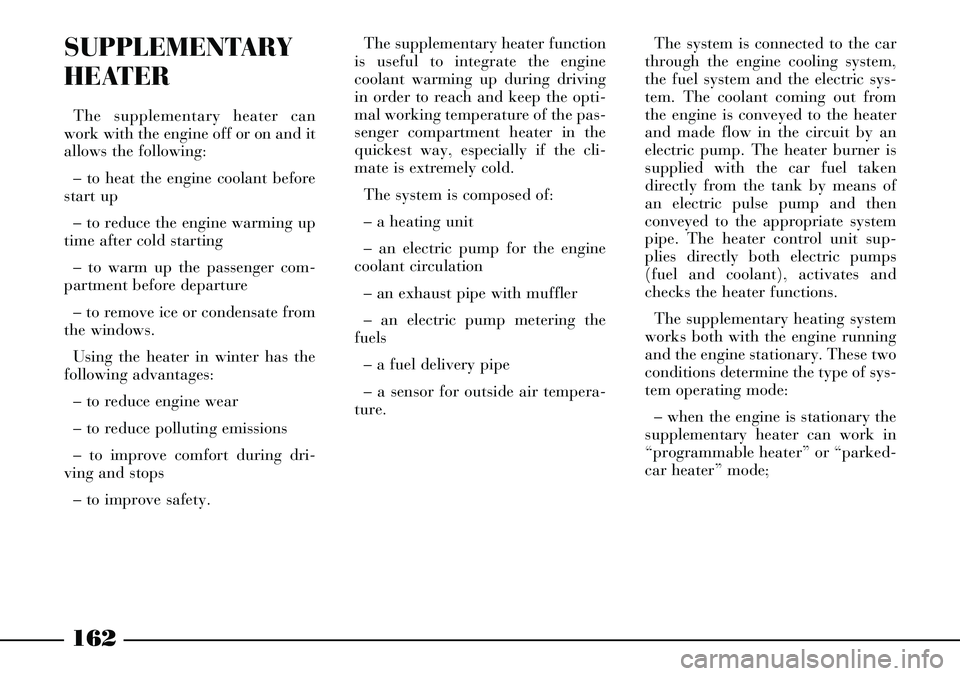
162
SUPPLEMENTARY
HEATER
The supplementary heater can
work with the engine off or on and it
allows the following:
– to heat the engine coolant before
start up
– to reduce the engine warming up
time after cold starting
– to warm up the passenger com-
partment before departure
– to remove ice or condensate from
the windows.
Using the heater in winter has the
following advantages:
– to reduce engine wear
– to reduce polluting emissions
– to improve comfort during dri-
ving and stops
– to improve safety.The supplementary heater function
is useful to integrate the engine
coolant warming up during driving
in order to reach and keep the opti-
mal working temperature of the pas-
senger compartment heater in the
quickest way, especially if the cli-
mate is extremely cold.
The system is composed of:
– a heating unit
– an electric pump for the engine
coolant circulation
– an exhaust pipe with muffler
– an electric pump metering the
fuels
– a fuel delivery pipe
– a sensor for outside air tempera-
ture.The system is connected to the car
through the engine cooling system,
the fuel system and the electric sys-
tem. The coolant coming out from
the engine is conveyed to the heater
and made flow in the circuit by an
electric pump. The heater burner is
supplied with the car fuel taken
directly from the tank by means of
an electric pulse pump and then
conveyed to the appropriate system
pipe. The heater control unit sup-
plies directly both electric pumps
(fuel and coolant), activates and
checks the heater functions.
The supplementary heating system
works both with the engine running
and the engine stationary. These two
conditions determine the type of sys-
tem operating mode:
– when the engine is stationary the
supplementary heater can work in
“programmable heater” or “parked-
car heater” mode;
Page 164 of 386
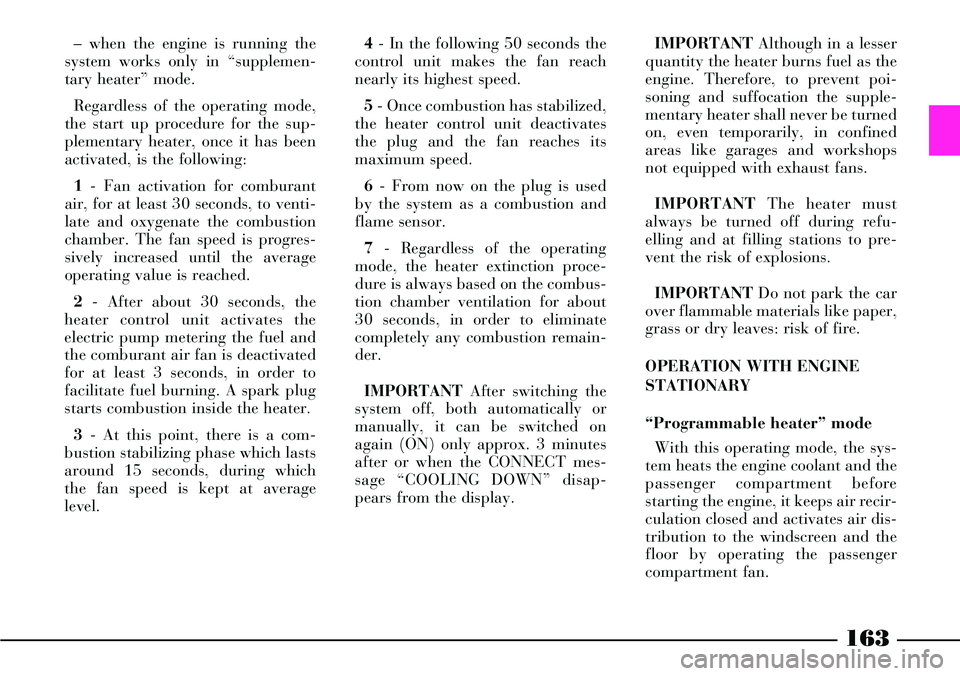
163
– when the engine is running the
system works only in “supplemen-
tary heater” mode.
Regardless of the operating mode,
the start up procedure for the sup-
plementary heater, once it has been
activated, is the following:
1- Fan activation for comburant
air, for at least 30 seconds, to venti-
late and oxygenate the combustion
chamber. The fan speed is progres-
sively increased until the average
operating value is reached.
2- After about 30 seconds, the
heater control unit activates the
electric pump metering the fuel and
the comburant air fan is deactivated
for at least 3 seconds, in order to
facilitate fuel burning. A spark plug
starts combustion inside the heater.
3- At this point, there is a com-
bustion stabilizing phase which lasts
around 15 seconds, during which
the fan speed is kept at average
level.4- In the following 50 seconds the
control unit makes the fan reach
nearly its highest speed.
5- Once combustion has stabilized,
the heater control unit deactivates
the plug and the fan reaches its
maximum speed.
6- From now on the plug is used
by the system as a combustion and
flame sensor.
7- Regardless of the operating
mode, the heater extinction proce-
dure is always based on the combus-
tion chamber ventilation for about
30 seconds, in order to eliminate
completely any combustion remain-
der.
IMPORTANTAfter switching the
system off, both automatically or
manually, it can be switched on
again (ON) only approx. 3 minutes
after or when the CONNECT mes-
sage “COOLING DOWN” disap-
pears from the display. IMPORTANTAlthough in a lesser
quantity the heater burns fuel as the
engine. Therefore, to prevent poi-
soning and suffocation the supple-
mentary heater shall never be turned
on, even temporarily, in confined
areas like garages and workshops
not equipped with exhaust fans.
IMPORTANTThe heater must
always be turned off during refu-
elling and at filling stations to pre-
vent the risk of explosions.
IMPORTANTDo not park the car
over flammable materials like paper,
grass or dry leaves: risk of fire.
OPERATION WITH ENGINE
STATIONARY
“Programmable heater” mode
With this operating mode, the sys-
tem heats the engine coolant and the
passenger compartment before
starting the engine, it keeps air recir-
culation closed and activates air dis-
tribution to the windscreen and the
floor by operating the passenger
compartment fan.
Page 165 of 386
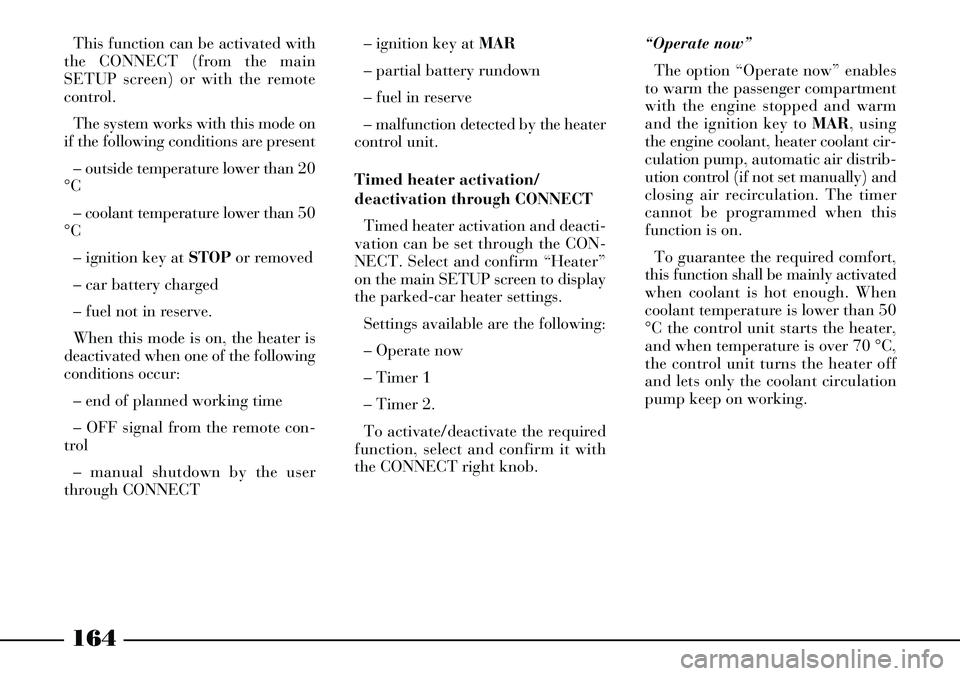
164
This function can be activated with
the CONNECT (from the main
SETUP screen) or with the remote
control.
The system works with this mode on
if the following conditions are present
– outside temperature lower than 20
°C
– coolant temperature lower than 50
°C
– ignition key at STOPor removed
– car battery charged
– fuel not in reserve.
When this mode is on, the heater is
deactivated when one of the following
conditions occur:
– end of planned working time
– OFF signal from the remote con-
trol
– manual shutdown by the user
through CONNECT– ignition key at MAR
– partial battery rundown
– fuel in reserve
– malfunction detected by the heater
control unit.
Timed heater activation/
deactivation through CONNECT
Timed heater activation and deacti-
vation can be set through the CON-
NECT. Select and confirm “Heater”
on the main SETUP screen to display
the parked-car heater settings.
Settings available are the following:
– Operate now
– Timer 1
– Timer 2.
To activate/deactivate the required
function, select and confirm it with
the CONNECT right knob.“Operate now”
The option “Operate now” enables
to warm the passenger compartment
with the engine stopped and warm
and the ignition key to MAR, using
the engine coolant, heater coolant cir-
culation pump, automatic air distrib-
ution control (if not set manually) and
closing air recirculation. The timer
cannot be programmed when this
function is on.
To guarantee the required comfort,
this function shall be mainly activated
when coolant is hot enough. When
coolant temperature is lower than 50
°C the control unit starts the heater,
and when temperature is over 70 °C,
the control unit turns the heater off
and lets only the coolant circulation
pump keep on working.
Page 166 of 386
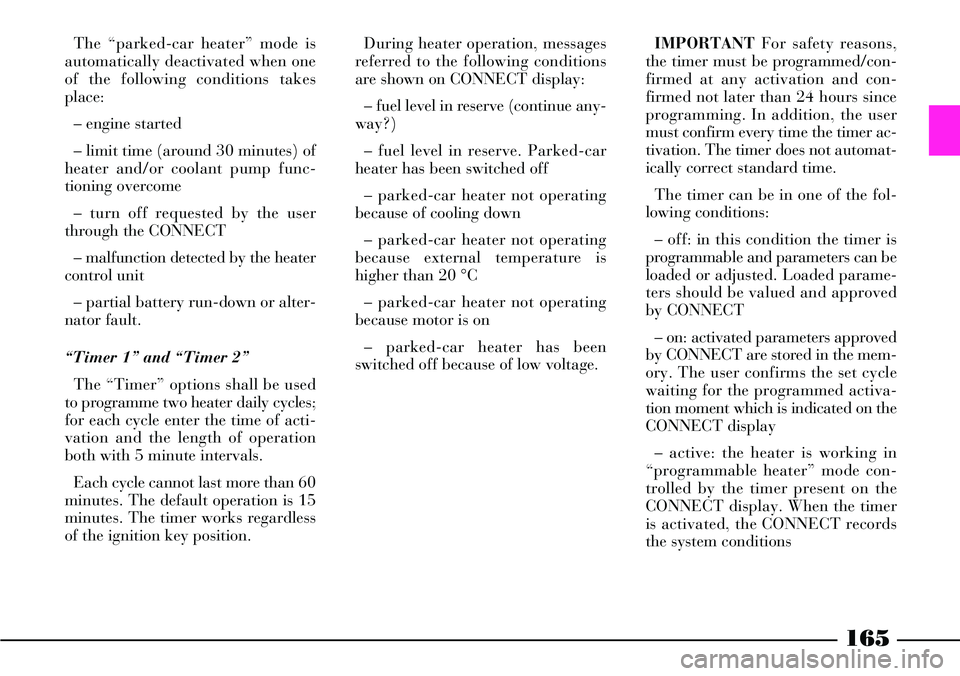
165
The “parked-car heater” mode is
automatically deactivated when one
of the following conditions takes
place:
– engine started
– limit time (around 30 minutes) of
heater and/or coolant pump func-
tioning overcome
– turn off requested by the user
through the CONNECT
– malfunction detected by the heater
control unit
– partial battery run-down or alter-
nator fault.
“Timer 1” and “Timer 2”
The “Timer” options shall be used
to programme two heater daily cycles;
for each cycle enter the time of acti-
vation and the length of operation
both with 5 minute intervals.
Each cycle cannot last more than 60
minutes. The default operation is 15
minutes. The timer works regardless
of the ignition key position.During heater operation, messages
referred to the following conditions
are shown on CONNECT display:
– fuel level in reserve (continue any-
way?)
– fuel level in reserve. Parked-car
heater has been switched off
– parked-car heater not operating
because of cooling down
– parked-car heater not operating
because external temperature is
higher than 20 °C
– parked-car heater not operating
because motor is on
– parked-car heater has been
switched off because of low voltage.IMPORTANTFor safety reasons,
the timer must be programmed/con-
firmed at any activation and con-
firmed not later than 24 hours since
programming. In addition, the user
must confirm every time the timer ac-
tivation. The timer does not automat-
ically correct standard time.
The timer can be in one of the fol-
lowing conditions:
– off: in this condition the timer is
programmable and parameters can be
loaded or adjusted. Loaded parame-
ters should be valued and approved
by CONNECT
– on: activated parameters approved
by CONNECT are stored in the mem-
ory. The user confirms the set cycle
waiting for the programmed activa-
tion moment which is indicated on the
CONNECT display
– active: the heater is working in
“programmable heater” mode con-
trolled by the timer present on the
CONNECT display. When the timer
is activated, the CONNECT records
the system conditions